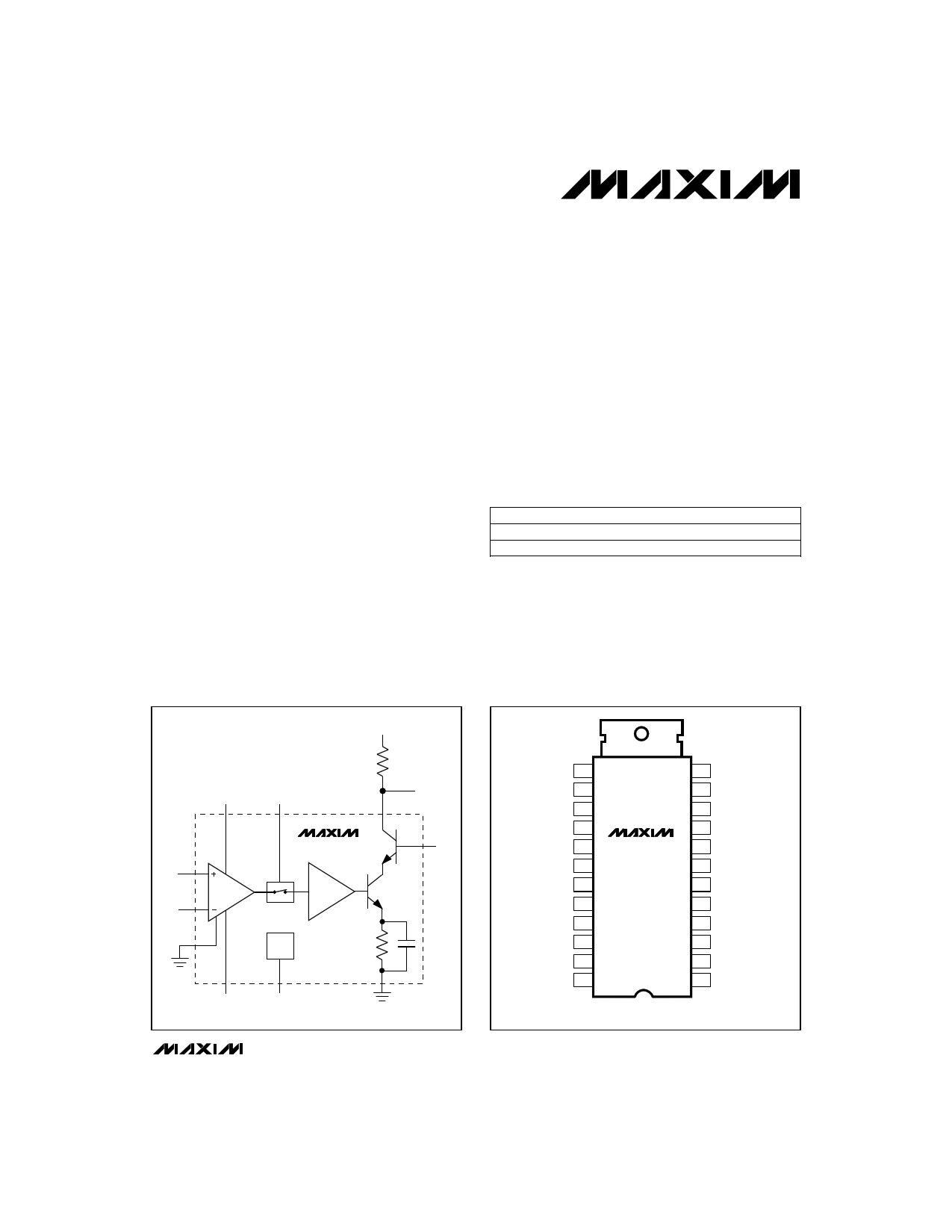
|
|
PDF MAX445 Data sheet ( Hoja de datos )
| Número de pieza | MAX445 | |
| Descripción | 200MHz Video CRT Driver | |
| Fabricantes | Maxim Integrated | |
| Logotipo |  |
|
Hay una vista previa y un enlace de descarga de MAX445 (archivo pdf) en la parte inferior de esta página. Total 8 Páginas | ||
|
No Preview Available !
19-0302; Rev 0; 9/94
Low-Cost, High-Resolution, 200MHz
Video CRT Driver
_______________General Description
The MAX445 is a high-performance, monolithic, variable-
gain transconductance amplifier with a high-voltage
open-collector output capable of directly driving a video
display (CRT cathode). A 2.5ns rise time is achieved
using a peaking network with a 200Ω load resistor and
an 8pF total load (CRT and parasitic capacitance).
Differential inputs and a linear adjustable gain stage
with an output offset adjustment make the versatile
MAX445 well suited for many video display applica-
tions. A buffered bandgap reference voltage is avail-
able for the gain (contrast) and offset adjustments
along with a TTL BLANK input to turn off the output cur-
rent, independent of signal input.
The MAX445 is available in a 24-pin power-tab DIP
package. A suitable heatsink must be attached to
maintain the junction temperature within the recom-
mended operating range.
________________________Applications
CRT Driver for High-Resolution Monochrome and
Color Displays
High-Voltage, Variable-Gain Transconductance
Amplifier
____________________________Features
o 2.5ns Rise/Fall Time into an 8pF Load
o 200MHz Small-Signal Bandwidth
o 50Vp-p Output
o Ground Referenced Differential Inputs
o Linear Variable Gain for Contrast Control
o Offset Adjustment for Black Level
o 5.5V Bandgap Reference
o Drives 1280 x 1024 and 1530 x 1280 Displays
______________Ordering Information
PART
MAX445CPG
MAX445C/D
TEMP. RANGE
0°C to +70°C*
0°C to +70°C**
PIN-PACKAGE
24 Power-Tab DIP
Dice
* Case temperature range, TCASE = 0°C to +90°C. See Absolute
Maximum Ratings and Applications Information for thermal/heat
sink considerations.
**Dice are specified at TJ = +25°C, DC parameters only.
________________Functional Diagram
CONTRAST
BLANK
VAA
RL
VOUT
IOUT
VIN+
VIN-
GNDA
MAX445
PRE-AMP
CURRENT
AMP
BAND
GAP
VCB
OFFSET
VREF
GND
__________________Pin Configuration
TOP VIEW
GND
VREF
OFFSET
CONTRAST
GNDA
VIN-
VIN+
VEE
VEE
VCC
BLANK
GND
1
2
3
4
5
6
7
8
9
10
11
12
MAX445
24 GND
23 GND
22 GND
21 VEEO
20 N.C.
19 IOUT
18 N.C.
17 VCB
16 VCB
15 GND
14 GND
13 GND
Power-Tab DIP
________________________________________________________________ Maxim Integrated Products 1
Call toll free 1-800-998-8800 for free samples or literature.
http://www.Datasheet4U.com
1 page 
Low-Cost, High-Resolution, 200MHz
Video CRT Driver
IOUT
The MAX445’s output is an open collector of a cascode
amplifier. This output is designed to work with nominal
output supplies of VAA = +75V. The high-voltage supply
must be greater than any applied VCB voltage for proper
operation. The MAX445 sinks up to 250mA. Optimum
performance into a capacitive load can be achieved
when an impedance-matching network is used.
VCB
The output stage consists of a common-base, high-voltage
stage and a high-speed, low-voltage current amplifier in a
cascode arrangement. The VCB input is the base connec-
tion to the common-base device of this stage. Be sure to
provide a stable DC voltage at this pin of nominally +10V.
High-frequency compensation at this input is required to
avoid output oscillations. Use a series 24Ω resistor to sup-
ply, shunted with a 10pF capacitor to ground (Figure 1).
Smaller values of this RC combination will improve output
rise/fall times, but can cause output oscillations.
Power Supplies
+10V and -10.5V supplies are required for proper opera-
tion. These supplies can be set to ±12V for conve-
nience, however this will add additional component
power dissipation. The high-voltage supply, VAA, can be
any voltage between VCB + 10V and VCB + 65V.
VEEO (pin 21) is the negative supply to the output stage
and must be DC connected to VEE (pins 8 and 9), the
most negative voltage applied to the device. However,
VEEO must be decoupled from VEE to prevent output
oscillations. A ferrite bead and separate 0.1µF decou-
pling capacitors, as shown in Figure 1, will provide
appropriate decoupling.
Power-Supply Sequencing
Power-supply sequencing is important to avoid internal
device latchup. To avoid sequencing problems, external
diodes should be placed from VEE to ground, from
ground to VCC, and from VCC to the output supply (VAA),
as shown in Figure 1. With diodes used as shown, spe-
cial power-supply sequencing is not required.
CRT Arc Protection
The MAX445 must be protected from electrostatic dis-
charge (“arcs”) from the CRT. It is recommended that the
output be clamped with a low-capacitance (less than
2pF) diode to the VAA supply. The peak current-handling
capability required of the diode is a function of the CRT
arc characteristics, but typically should be 1A or more,
such as Philips BAV20 or Hitachi 1SS91. For additional
information regarding arc protection, contact Maxim’s
applications department.
Impedance Matching Network
For maximum speed from the MAX445, be sure to
“match” the output to the CRT. Figure 1’s typical connec-
tion diagram shows a network (including parasitic reac-
tances) associated with arc protection devices, CRT
wiring and grid structure, and load resistors. These para-
sitic reactances are all detrimental to good transient
response and should be minimized as much as possible.
CL is the grid-to-cathode capacitance of the CRT, plus
any parasitic capacitance to ground associated with the
cathode structure. This capacitance varies from tube-
type to tube-type over the 4pF to 12pF range.
In Figure 1, LS is the inductance of the lead from the
amplifier board to the CRT cathode and the return path
from the grid to circuit ground. A wire in free space has
an inductance of 20nH/inch to 25nH/inch. With care, the
total path through the CRT gun can be kept at 1.5 to 2
inches, such that LS ranges from 30nH to 50nH.
Excessive lead length will cause undesirable overshoot
and ringing in the transient response.
The peaking networks assume that 2pF of parasitic
capacitance is associated with the CRT arc protection
diode connected at the junction of L3 and L1.
Lr is the parasitic inductance of the load resistor, RL. In
some cases, CR may be needed to improve step
response.
RS is a damping resistor in series with the CRT grid.
It also provides current limiting in the event of CRT
arcing.
The equations for determining optimum peaking net-
work values are as follows:
L1 = (RL)2 (CL) / 4
L2 = 3(RL)2 (CL) / 4
CB = CL / 5
RS = RL / 2
L3 = k3 (RL)2 [2.5 x 10-12]
CR (optional) = Lr / (2RL2)
k3 is an empirically determined factor increasing with
CL and varying from 0 for CL ~ 2pF to 1 for CL ~ 12pF.
However, L3 >100nH will compromise large-signal per-
formance.
Table 1 shows peaking networks for the nominal load,
RL = 200Ω (and RS = 100Ω).
Optimum peaking depends on board layout and CRT
construction. The values given by these equations
should be used as starting points for empirically deter-
mining optimum values.
_______________________________________________________________________________________ 5
http://www.Datasheet4U.com
5 Page | ||
| Páginas | Total 8 Páginas | |
| PDF Descargar | [ Datasheet MAX445.PDF ] | |
Hoja de datos destacado
| Número de pieza | Descripción | Fabricantes |
| MAX440 | High-Speed Video Multiplixer/Amplifier | Maxim Integrated |
| MAX4400 | Rail-to-Rail Op Amps | Maxim Integrated |
| MAX44000 | Ambient and Infrared Proximity Sensor | Maxim Integrated Products |
| MAX44004 | Digital Ambient Light Sensor | Maxim Integrated |
| Número de pieza | Descripción | Fabricantes |
| SLA6805M | High Voltage 3 phase Motor Driver IC. |
Sanken |
| SDC1742 | 12- and 14-Bit Hybrid Synchro / Resolver-to-Digital Converters. |
Analog Devices |
|
DataSheet.es es una pagina web que funciona como un repositorio de manuales o hoja de datos de muchos de los productos más populares, |
| DataSheet.es | 2020 | Privacy Policy | Contacto | Buscar |
